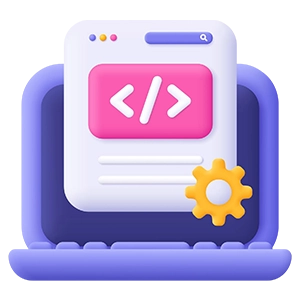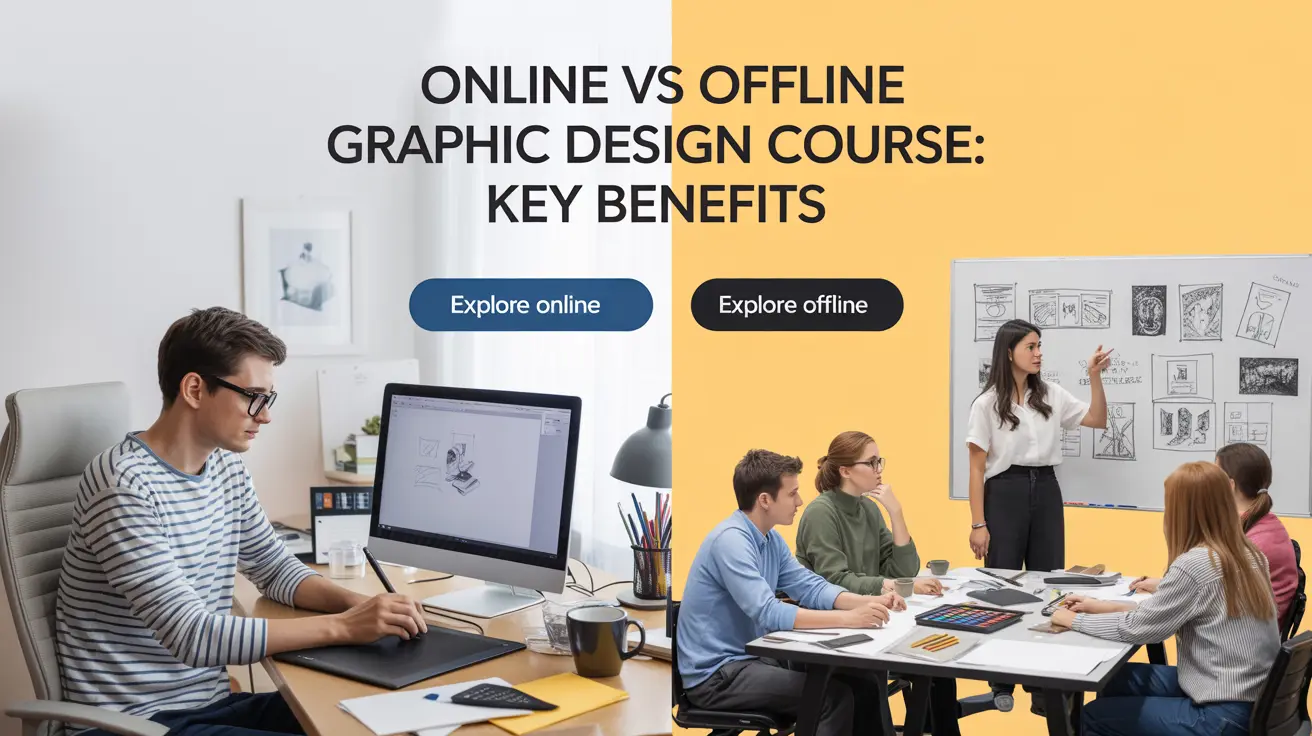The field of graphic design is evolving rapidly, with businesses and individuals increasingly relying on visual content to communicate, market, and build brand identity. As the demand for skilled designers grows, so does the interest in acquiring graphic design education. One of the biggest decisions aspiring designers face is choosing between an online vs offline graphic design course. With so many options available, it’s crucial to understand the key differences and benefits of online vs offline graphic design courses. This comprehensive guide provides a graphic design course comparison to help you make an informed choice tailored to your learning style and goals.
What is a Graphic Design Course?
A graphic design course is a structured learning program that teaches the principles, tools, and techniques used in creating visual content. These courses cover a range of topics, including typography, color theory, layout design, branding, user interface (UI) and user experience (UX) design, and software like Adobe Photoshop, Illustrator, and InDesign.
Graphic design courses aim to equip students with the skills necessary to communicate ideas effectively through visuals. Whether you choose to learn graphic design online or offline, both formats typically offer:
- Foundational theory and principles
- Practical assignments and projects
- Software training
- Portfolio development
- Peer and instructor feedback
Understanding what’s included helps in assessing the benefits of online vs offline graphic design course formats.
Online vs Offline Graphic Design Course
| Feature | Online Course | Offline Course |
|---|---|---|
| Flexibility | High – learn anytime, anywhere | Fixed schedule and location |
| Cost | More affordable | Higher (includes travel, living costs) |
| Access to Experts | Global instructors | Limited to local professionals |
| Learning Mode | Self-paced, video + live sessions | In-person, classroom-based learning |
| Skill Development | Portfolio-based digital projects | Instructor-led assignments & group tasks |
| Networking | Online forums, LinkedIn | Peer groups, offline events |
| Job Support | Depends on platform | Varies by institute reputation |
| Tools | Learn latest cloud-based & AI tools | Access to studio infrastructure |
Online Graphic Design Courses
Online graphic design courses have grown in popularity due to technological advancements and the flexibility they offer. Delivered via platforms like Coursera, Udemy, Skillshare, and even accredited institutions, these courses can range from short tutorials to full-fledged degree programs.

Online Design Course Advantages
1. Flexibility and Convenience
One of the primary online design course advantages is the ability to learn at your own pace. Whether you’re a student, a working professional, or a stay-at-home parent, you can fit learning into your schedule.
2. Accessibility from Anywhere
Online courses remove geographical barriers, allowing you to learn from top institutions without relocating or commuting.
3. Wide Range of Courses
Online platforms offer a vast selection of courses catering to all skill levels—from beginner to advanced—providing specialized topics like motion graphics, 3D design, or branding.
4. Affordability
Compared to traditional classroom programs, online courses are generally more affordable. Many platforms even offer free courses or financial aid.
5. Self-Paced Learning
You can revisit lectures and take the time you need to master each concept, which enhances understanding and retention.
6. Lifetime Access to Materials
Many platforms offer lifetime access to course materials, enabling continuous learning and reference.
7. Global Networking Opportunities
Interacting with peers from around the world exposes you to diverse design perspectives and opportunities.
These features highlight why many students prefer to learn graphic design online.
Offline Graphic Design Course
Offline graphic design courses are traditional, classroom-based programs offered by universities, art schools, and training institutes. These courses usually follow a fixed schedule and take place in physical classrooms or labs.

Offline Graphic Design Course
1. Structured Learning Environment
A classroom setting provides a disciplined environment with fixed schedules, which can be beneficial for students who thrive on routine.
2. Immediate Feedback and Support
Direct interaction with instructors allows for real-time feedback, immediate clarification of doubts, and personalized mentoring.
3. Hands-On Experience
Access to high-end software, design studios, and printing labs can enhance the learning experience.
4. Collaborative Projects and Networking
Working alongside peers encourages collaboration, idea exchange, and teamwork—skills crucial for real-world projects.
5. Certification and Accreditation
Many offline courses are part of degree or diploma programs, which may carry more weight in certain job markets.
6. Stronger Focus and Fewer Distractions
A dedicated learning environment minimizes distractions, enhancing concentration and productivity.
For learners who value face-to-face instruction and structured schedules, offline courses offer compelling benefits of offline graphic design courses.
Who Should Choose What?
Your personal goals, learning preferences, and lifestyle play a significant role in determining whether to learn graphic design online or offline. Here’s a breakdown:
Online Courses Are Best For:
- Self-motivated learners
- Working professionals looking to upskill
- Those with limited time or budget
- Learners comfortable with technology and self-study
- People living in remote areas without access to design schools
Offline Courses Are Best For:
- Students who prefer face-to-face interaction
- Individuals seeking structured learning
- Those who benefit from peer collaboration
- Beginners who need more guidance
- Learners pursuing a degree or diploma for career advancement
Understanding your personal learning style is key to making the right decision in the online vs offline graphic design course debate.
Conclusion
Graphic design is an exciting and dynamic field, offering vast career opportunities across industries. Choosing between an online vs offline graphic design course depends on your specific needs, learning preferences, budget, and career goals.
Online design course advantages include flexibility, affordability, and accessibility, making them ideal for self-directed learners. On the other hand, offline courses provide a structured environment, hands-on experience, and in-person mentorship beneficial for those who thrive in traditional academic settings.
By weighing the benefits of online vs offline graphic design course options and understanding the core elements of each, you can make an informed choice that sets you on a path to success. Whether you decide to learn graphic design online or offline, the most important step is to begin.
FAQ
The key difference lies in the mode of delivery. An online graphic design course offers flexibility, self-paced learning, and remote access, while an offline course provides hands-on instruction, in-person mentorship, and classroom interaction. Choosing between the two depends on your learning style, schedule, and goals.
The benefits of online vs offline graphic design course options vary. Online learning is ideal for convenience and global access to instructors, while offline classes often offer stronger peer collaboration and structured environments. Many learners now prefer hybrid models that combine the best of both.
Beginners can succeed in both formats. If you're self-motivated and tech-savvy, learning graphic design online might be perfect for you. However, if you prefer direct feedback and guided instruction, offline learning could offer a better foundation.
Consider your schedule, budget, learning preferences, and career goals. Online courses are often more affordable and flexible, while offline programs offer immersive experiences. This graphic design course comparison can help you decide what suits your needs best.
Yes! Many industry-recognized online graphic design courses offer certifications, portfolio-building projects, and real-world assignments that employers value. What matters most is your skills, portfolio, and ability to apply design principles—not where you learned them.
Yes, many online graphic design courses are just as effective as offline programs, especially when they include live sessions, mentorship, and practical projects. The key is choosing a course that offers comprehensive content, tools training, and portfolio development.
To learn graphic design online, you'll need a computer with good processing power, a stable internet connection, and access to design tools like Adobe Creative Cloud, Figma, or Canva. A graphic tablet is optional but useful for illustration and detailed work.
Yes, offline graphic design courses often offer in-person networking, real-time feedback, and team-based projects. However, many online platforms now include community forums, live webinars, and collaborative projects to simulate the same benefits.
Whether online or offline, choose a graphic design course that covers essential tools (Photoshop, Illustrator, Figma), design principles, portfolio development, and real-world projects. Mentorship and job placement support are valuable extras.
Generally, it’s more cost-effective to learn graphic design online, as there are no commute or material costs. Many online platforms also offer lifetime access or subscription-based models, making them budget-friendly for beginners.
🎓 Need Help Creating a Portfolio?
Join our
or
build more than just skills—you’ll build confidence and a real portfolio that gets noticed.
- Learn Adobe Photoshop, Illustrator, InDesign & Figma
- Work on real-world design briefs
- Get one-on-one portfolio feedback
- Build a client-ready digital portfolio
- Learn how to present and pitch your work confidently
Turn your creativity into a career that’s future-proof.









